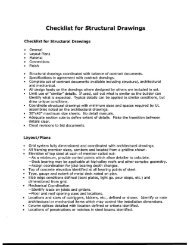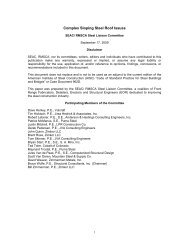Architecturally Exposed Structural Steel - Arquitectura en acero
Architecturally Exposed Structural Steel - Arquitectura en acero
Architecturally Exposed Structural Steel - Arquitectura en acero
Create successful ePaper yourself
Turn your PDF publications into a flip-book with our unique Google optimized e-Paper software.
This sample shows typical weld show-through from welding the connection<br />
on the far side of the piece.<br />
B. Fabricate AESS with exposed surfaces smooth,<br />
square and of surface quality consist<strong>en</strong>t with the<br />
approved mock up. Use special care in handling<br />
and shipping of AESS both before and after shop<br />
painting.<br />
C. In addition to special care used to handle and fabricate<br />
AESS, employ the following fabrication techniques.<br />
Editor’s Note: The following is a list of special fabrication methods<br />
that may impact the final appearance of the AESS. Many of<br />
these items have significant cost premiums and should not be<br />
used indiscriminately. Refer to the cost matrix for anticipated<br />
range of added cost associated with each line item.<br />
1. Fabrication Tolerance: Fabricate steel to one<br />
half the normal tolerance as specified in the<br />
Code of Standard Practice Section 10.<br />
2. Welds ground smooth: Fabricator shall grind<br />
welds of AESS smooth. For groove welds, the<br />
weld shall be made flush to the surfaces each<br />
side and be within + 1 /16”, -0” of plate thickness.<br />
3. Contouring and bl<strong>en</strong>ding of welds: Where fillet<br />
welds are indicated to be ground-contoured,<br />
or bl<strong>en</strong>ded, oversize welds as required<br />
and grind to provide a smooth transition and<br />
to match profile on approved mock-up.<br />
Weld show-through has be<strong>en</strong> minimized.<br />
4. Continuous Welds: Where welding is noted on<br />
the drawings, provide continuous welds of a<br />
uniform size and profile.<br />
5. Minimize Weld Show Through: At locations<br />
where welding on the far side of an exposed<br />
connection occurs, grind distortion and marking<br />
of the steel to a smooth profile with adjac<strong>en</strong>t<br />
material.<br />
6. Coping and Blocking Tolerance: Maintain a<br />
uniform gap of 1 /8” ± 1 /32” at all copes and<br />
blocks.<br />
7. Joint Gap Tolerance: Maintain a uniform gap<br />
of 1 /8” ± 1 /32”.<br />
8. Piece Marks Hidd<strong>en</strong>: Fabricate such that piece<br />
marks are fully hidd<strong>en</strong> in the final structure or<br />
made with such media to permit full removal<br />
after erection.<br />
10. Mill Mark Removal: Fabricator shall deliver<br />
steel with no mill marks (st<strong>en</strong>ciled, stamped,<br />
raised etc) in exposed locations. Mill marks<br />
shall be omitted by cutting of mill material to<br />
appropriate l<strong>en</strong>gths where possible. Where not<br />
possible, the fabricator can fill and/or grind to<br />
a surface finish consist<strong>en</strong>t with the approved<br />
mock up.<br />
May 2003 Modern <strong>Steel</strong> Constrution AESS Supplem<strong>en</strong>t 9







